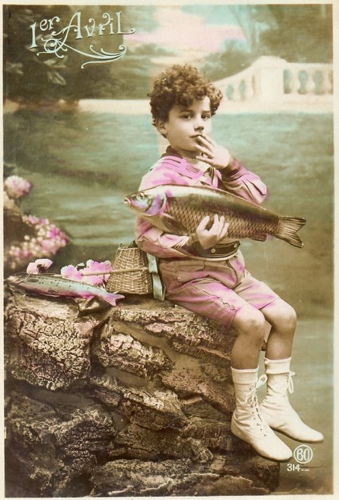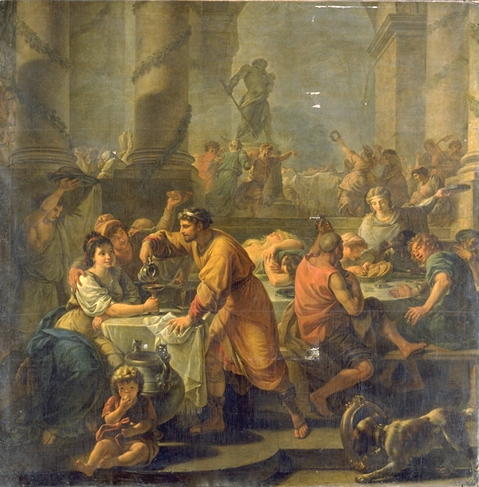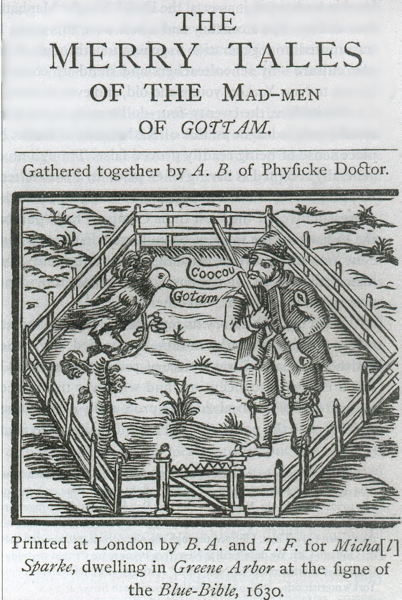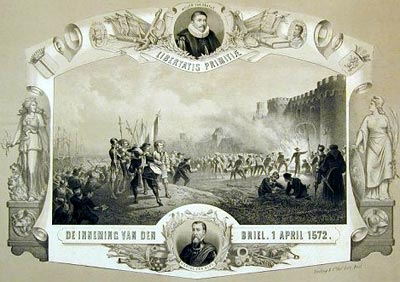In 1708 a correspondent wrote to the British
Apollo magazine asking, "Whence proceeds the custom of making April Fools?" The question is one that many people are still asking today.
The puzzle that April Fool's Day presents to cultural historians is that it was only during the eighteenth century that detailed references to it (and curiosity about it) began to appear. But at that time, the custom was already well established throughout northern Europe and was regarded as being of great antiquity. How had the tradition been adopted by so many different European cultures without provoking more comments in the written record?
References to April Fool's Day can be found as early as the 1500s. However, these early references were infrequent and tended to be vague and ambiguous. Shakespeare, writing in the late sixteenth and early seventeenth centuries, made no mention of April Fool's Day, despite being, as Charles Dickens Jr. put it, a writer who "delights in fools in general."
Many theories have been put forward about how the tradition began. Unfortunately, none of them are very compelling. So the origin of the "custom of making April Fools" remains as much a mystery to us as it was back in 1708.
The Calendar-Change Theory
The most popular theory about the origin of April Fool's Day involves the French calendar reform of the sixteenth century.
The theory goes like this: In 1564 France reformed its calendar, moving the start of the year from the end of March to January 1. Those who failed to keep up with the change, who stubbornly clung to the old calendar system and continued to celebrate the New Year during the week that fell between March 25th and April 1st, had jokes played on them. Pranksters would surreptitiously stick paper fish to their backs. The victims of this prank were thus called Poisson d'Avril, or April Fish -- which, to this day, remains the French term for April Fools -- and so the tradition was born.

A French "poisson d'Avril" or "April Fish" postcard.
The calendar-change hypothesis seems, on the surface, like a logical explanation for the origin of April Fools. However, the hypothesis becomes less plausible if we examine the history of calendar reform in more detail.
The Julian Calendar
The Julian Calendar, established by Julius Caesar in 46 BC, made January 1 the first day of the year. But as Christianity spread throughout Europe, efforts were made to christianize the calendar by moving New Year's Day to dates of greater theological significance, such as Christmas or Easter. Some countries continued to use January 1, justifying this as the date of Christ's circumcision. As a consequence, by the 1500s the European calendar system was a mess. Not only had errors in the Julian calendar caused the solar year to diverge from the calendar year, but also countries were beginning the year on different dates.
Most regions in France had been using Easter as the start of the year since at least the fourteenth century. This caused particular confusion since the date of Easter was tied to the lunar cycle and changed from one year to the next. Sometimes the same date would occur twice in a year.
However, the French used Easter as the start of the year primarily for legal and administrative purposes. January 1, following the Roman custom, was widely regarded as the traditional start of the year, and it was the day when people exchanged gifts.
Sixteenth-Century Reform
The practice of starting the year on Easter Day caused enormous practical inconvenience, so around 1500 many people in France began to use January 1 as the start of the calendar year. For instance, in early sixteenth-century French books, it is common to see both forms of dating listed side-by-side (for titles published in January, February, or March). By the mid-sixteenth century, a calendar system beginning on January 1 was in wide use in France.
In 1563 King Charles IX decreed January 1 to be the first day of the year, thus aligning legal convention with what had become the popular practice. His edict was passed into law by the French Parliament on Dec. 22, 1564.
Eighteen years later, in 1582, Pope Gregory issued a papal bull decreeing sweeping calendar reform. The Gregorian reform included moving the start of the year to January 1, as well as creating a leap-year system and eliminating ten days from the month of October 1582 in order to correct the drift of the calendar. The Pope had no formal power to make governments accept this reform, but he urged Christian nations to do so. France immediately accepted the reform, although it had already changed the start of the year in 1564. (Many histories of April Fool's Day mistakenly suggest that France only moved the start of the year in 1582 when it accepted the Gregorian calendar reform in its entirety.)

Commission for the Reform of the Calendar (Pope Gregory XIII Presiding), Biccherna Tablet, 1582.
With this history in mind, it becomes clear that the calendar-change hypothesis is a problematic explanation for the origin of April Fool's Day. The switch to January 1 did not occur suddenly in France. It was a gradual process, spanning an entire century. And even before the switch, the French New Year had no obvious connection to April 1st.
British Calendar Change
The calendar-change hypothesis is more plausible if applied to Britain, because it was the British,
not the French, who observed New Year's Day on March 25 (the date of the christian Feast of Annunciation), followed by a week of festivities culminating on April 1. In fact, the earliest version of the calendar-change hypothesis to be found in print, dating from 1766, does place the argument in a British context. A correspondent to the
Gentleman's Magazine in April 1766 wrote:
The strange custom prevalent throughout this kingdom, of people making fools of one another upon the first of April, arose from the year formerly beginning, as to some purpose, and in some respects, on the twenty-fifth of March, which was supposed to be the incarnation of our Lord; it being customary with the Romans, as well as with us, to hold a festival, attended by an octave, at the commencement of the new year -- which festival lasted for eight days, whereof the first and last were the principal; therefore the first of April is the octave of the twenty-fifth of March, and, consequently, the close or ending of the feast, which was both the festival of the Annunciation and the beginning of the new year.
Britain only changed the start of its calendar year to January 1 in 1752. By this time April Fool's Day was already a well-established tradition. So confusion about the calendar change could not have been responsible for the origin of the custom in Britain. But it is possible, as the correspondent to
Gentleman's Magazine speculated, that the festival held on April 1 (the "octave" of the March 25th calendar year change) evolved into April Fool's Day. However, this is pure speculation, undermined by the lack of any other compelling evidence that the custom originated in Britain. The earliest unambiguous references to April Fool's Day actually come from continental Europe, suggesting it is there that April Fool's Day began.
Early References
Pre-eighteenth century references to April Fool's Day provide clues about where the custom originated. Unfortunately, many of these references are ambiguous, and their significance is difficult to determine.
1392: Chaucer
What is possibly the first reference to April Fool's Day can be found in the work of Chaucer. Unfortunately, the reference is so ambiguous as to be worthless as historical evidence.
In the
Nun's Priest's Tale (written around 1392), Chaucer tells the story of the vain cock Chauntecler who falls for the tricks of a fox, and as a consequence is almost eaten. The narrator describes the tale as occurring:
When that the monthe in which the world bigan
That highte March, whan God first maked man,
Was complet, and passed were also
Syn March bigan thritty dayes and two
This passage has caused enormous confusion among Chaucer scholars, since it appears to be self-contradictory. Does it mean the events occur thirty-two days ("thritty dayes and two") after March "was complet" (i.e. May 3), or thirty-two days "Syn March bigan" (since March began), i.e. April 1? If the latter interpretation is correct, the tale takes place on April Fool's Day, which seems appropriate for a story of a foolish cock and sly fox. Could Chaucer have chosen this date purposefully, setting the tale on April 1st because of the tradition of tricks and foolery associated with the day?
Most editors of Chaucer don't think so. The most popular interpretation of this passage is that Chaucer meant May 3, so editors often change the text to read "Syn March [was gon]". However, the historian Peter Travis has argued that Chaucer did not intend to provide a precise date at all, but was instead purposefully using confusing language in order to parody the language of Medieval philosophy.
Whatever Chaucer may have meant, we can't conclude, based on these few lines, that he was aware of a custom of playing pranks on April 1st.
1508: Eloy d'Amerval
The next possible reference to April Fool's Day we find is in a 1508 poem written by Eloy d'Amerval, a French choirmaster and composer. The poem is titled
Le livre de la deablerie. According to
Wikipedia, it consists of "a dialogue between Satan and Lucifer, in which their nefarious plotting of future evil deeds is interrupted periodically by the author, who among other accounts of earthly and divine virtue, records useful information on contemporary musical practice."
The poem would only be of interest to historians of music, except that it includes the line, "maquereau infâme de maint homme et de mainte femme, poisson d'avril."
The phrase "poisson d'avril" (April Fish) is the French term for an April Fool, but it is unclear whether d'Amerval's use of the term referred to April 1st specifically. He might have intended the phrase simply to mean a foolish person.
1561: Eduard de Dene
The Flemish writer Eduard De Dene published a comical poem in 1561 about a nobleman who hatches a plan to send his servant back and forth on absurd errands on April 1st, supposedly to help prepare for a wedding feast. The servant recognizes that what's being done to him is an April 1st joke. The poem is titled "Refereyn vp verzendekens dach / Twelck den eersten April te zyne plach." This is late medieval Dutch meaning (roughly) "Refrain on errand-day / which is the first of April." In the closing line of each stanza, the servant says, "I am afraid... that you are trying to make me run a fool's errand." (Thanks to Marco Langbroek for the Dutch translation.)
At last, what we have here is a fairly clear reference to a custom of playing practical jokes on April 1st. So we can say that April Fool's Day dates back at least to the sixteenth century. Because of this reference (and the other, vague French reference), historians believe that April Fool's Day must have originated in continental northern Europe and then spread to Britain.
1632: Escape of the Duke of Lorraine
According to legend, the Duke of Lorraine and his wife were imprisoned at Nantes. They escaped on April 1, 1632 by disguising themselves as peasants and walking through the front gate. Someone noticed them escaping and told the guards. But the guards believed the warning to be a "poisson d'Avril" (or April Fool's Day joke) and laughed at it, thus allowing the Duke and his wife to escape.
It is not known if any part of this legend is true.
1686: John Aubrey
The English antiquarian John Aubrey collected many notes about popular customs and superstitions, as research for a contemplated work to be titled,
Remains of Gentilism and Judaism. In 1686 he wrote, "Fooles holy day. We observe it on ye first of April. And so it is kept in Germany everywhere." The collected notes were published posthumously.
So by the late seventeenth century, April Fool's Day had definitely spread to Britain.
1698: Washing the Lions
The April 2, 1698 edition of
Dawks's News-Letter (a British newspaper) reported that "Yesterday being the first of April, several persons were sent to the Tower Ditch to see the Lions washed." Sending gullible victims to the Tower of London to see the "washing of the lions" (a non-existent ceremony) was a popular prank. It became traditional for this prank to be played on April Fool's Day. Examples of it occur as late as the mid-nineteenth century. For more about the history of this prank, see the article:
Washing the Lions.
In the eighteenth century written references to April Fool's Day became numerous and appeared throughout Europe.
Renewal Festivals
Almost every culture in the world has some kind of festival in the first months of the year to celebrate the end of winter and the return of spring. Anthropologists call these "renewal festivals." Often they involve ritualized forms of mayhem and misrule. The wearing of disguises is common. People play pranks on friends and strangers. The social order is temporarily inverted. Servants might get to order around masters, or children challenge the authority of parents and teachers. However, the disorder is always bounded within a strict timeframe, and tensions are defused with laughter and comedy. The social order is symbolically challenged, but then restored, reaffirming the stability of the society, just as the cold months of winter temporarily challenge biological life, and yet the cycle of life continues, returning with the spring.
April Fool's Day has all the characteristics of a renewal festival. For one day forms of behavior that are normally not allowed (lying, deception, playing pranks) become acceptable, and yet the disorder is bounded within a strict timeframe. Traditionally, no pranks are supposed to be played after 12 o'clock noon of the first. Social hierarchies and tensions are exposed, but hostility is defused with laughter.
For as long as people have been speculating about April Fool's Day, they have noticed the similarities between it and other springtime "renewal" festivals. Many historians have theorized that April Fool's Day evolved directly out of some such festival practiced in ancient times. A direct connection between April Fool's Day and any of the Roman-era festivals seems unlikely, though it is quite possible that the tradition evolved out of a medieval festival held around the time of the Vernal equinox (such as the New Year's festivals at the end of March, as discussed above). Nevertheless, there is no agreement about which festival the tradition of April Foolery developed out of. Below is a list of some of the festivals that have most frequently been suggested as its forerunners.
The Saturnalia
The Saturnalia was a Roman winter festival observed at the end of December. It involved dancing, drinking, and general merrymaking. People exchanged gifts, slaves were allowed to pretend that they ruled their masters, and a mock king, the Saturnalicius princeps (or Lord of Misrule), reigned for the day. By the fourth century AD the Saturnalia had transformed into a January 1 New Year's Day celebration, and many of its traditions were incorporated into the observance of Christmas.

"Winter or Saturnalia" by Antoine-François Callet, 1782 or 1783
Hilaria
In late March the Romans honored the resurrection of Attis, son of the Great Mother Cybele, with the Hilaria celebration. This involved rejoicing and the donning of disguises.
Holi
Further afield in India, there was Holi, known as the festival of color, during which street celebrants threw colored powder and water at each other. This holiday was held on the full-moon day of the Hindu month of Phalguna (usually the end of February or the beginning of March).
Festival of Lud
Northern Europeans observed an ancient festival to honor Lud, a Celtic god of humor. There were also popular Northern European customs that made sport of the hierarchy of the Druids.
Feast of Fools
The medieval Festus Fatuorum (Feast of Fools) evolved out of the Saturnalia. On this day celebrants elected a Lord of Misrule and parodied church rituals, often in extremely blasphemous ways. The Church condemned the custom, but had little luck eradicating it despite frequent decrees forbidding it. It endured from the fifth century until the sixteenth century.
Regional British Festivals
Some festivals practiced in regions of Britain during the Middle Ages have similarities to April Fool's Day. Hoke-Tide (or Hock-Tide) was celebrated around Easter. Men and women would stop strangers of the opposite sex on the roads and tie them up, only untying them in return for money, which was to be used for a pious purpose. Various rowdy games would also be played. Shig-Shag (or Shick-Shack) Day was observed on May 20. Celebrants placed sprigs of apple oak in their hats or lapels. This was supposedly done to demonstrate loyalty to the monarchy, since Charles II was said to have hidden in an Oak Apple tree to escape the forces of Cromwell. However, the tradition probably had roots in pagan tree-worship customs. Anyone not wearing the oak might be accosted and mocked, but only until noon. After noon the obligation to "have shig-shag" ceased.
Mythological Origins
Scholars in the eighteenth and nineteenth centuries, suspecting April Fool's Day to be of great antiquity, occasionally tried to locate its origins in ancient mythology. Such theories never found wide acceptance, but they're included here since they were so often raised in discussions of April Fool's Day.
Roman Mythology
In Roman mythology Pluto, the God of the Dead, abducted Proserpina and brought her to live with him in the underworld. Proserpina called out to her mother Ceres (the Goddess of grain and the harvest) for help, but Ceres, who could only hear the echo of her daughter's voice, searched in vain for Proserpina. Some scholars theorized that the fruitless search of Ceres for her daughter (commemmorated during the Roman festival of Cerealia) was the mythological antecedent of the fool's errands popular on April 1st.
Christian Mythology
It was once popular to christianize April Fool's Day by locating its origin in Biblical traditions. For instance, the tradition was attributed to Noah's mistake of sending a dove out from the ark before the flood waters had subsided (thereby sending the dove on a fool's errand). A second story suggests that the day commemorates the time when Jesus was sent from Pilate to Herod and back again. The phrase "Sending a man from Pilate to Herod" (an old term for sending someone on a fool's errand) was often pointed to as proof of this origin theory.
National Origin Theories
There are theories of the origin of April Fool's Day specific to Great Britain, Germany, the Netherlands, and France. None of these theories offers a compelling explanation of the day's origin. However, it is a sign of the cross-cultural nature of the tradition that four different countries should attempt to take credit for it.
France
The French origin theory (the calendar-change hypothesis) was discussed above. It alleges that the custom originated when King Charles IX reformed the calendar, moving the start of the year from April 1 to January 1. People who continued to celebrate New Years on April 1 were mocked and had pranks played on them, thus initiating the custom of April 1st foolery. This has become, worldwide, the most popular theory of the origin of April Fool's Day, despite its flaws.
The French also have a theory that traces the origin of the custom back to the abundance of fish to be found in French streams and rivers during early April when the young fish had just hatched. These young fish were easy to fool with a hook and lure. Therefore, the French called them 'Poisson d'Avril' or 'April Fish.' Soon it became customary (according to this theory) to fool people on April 1, as a way of celebrating the abundance of foolish fish. The French still use the term 'Poisson d'Avril' to describe April Fool's Day pranks. They also observe the custom of giving each other chocolate fish on April 1.
Great Britain
British folklore links April Fool's Day to the town of Gotham, the legendary town of fools located in Nottinghamshire. According to the legend, it was traditional in the 13th century for any road that the King placed his foot upon to become public property. So when the citizens of Gotham heard that King John planned to travel through their town, they refused him entry, not wishing to lose their main road. When the King heard this, he sent soldiers to the town. But when the soldiers arrived in Gotham, they found the town full of lunatics engaged in foolish activities such as drowning fish or attempting to cage birds in roofless fences. Their foolery was all an act, but the King fell for the ruse and declared the town too foolish to warrant punishment. Ever since then, according to legend, April Fool's Day has commemmorated their trickery.

In this 1630 woodcut, a citizen of Gotham is shown
trying to trap a bird inside a roofless fence.
Germany
On April 1, 1530 a meeting of lawmakers was supposed to occur in Augsburg in order to consider various financial matters. Because of time considerations, the meeting did not take place. But numerous speculators, who had bet on the meeting occurring, lost their money and were ridiculed. This is said to have been the origin of the tradition of playing pranks on April 1.
The Netherlands
On April 1, 1572 Dutch rebels captured the town of Den Briel from Spanish troops led by Lord Alva. This military success eventually led to the independence of the Netherlands from Spain. A Dutch rhyme goes: "Op 1 april / Verloor Alva zijn Bril." This translates to: "On April 1st / Alva lost his 'glasses'". "Bril" means glasses in Dutch, but is also a pun on the name of the town, Den Briel. It is claimed that the tradition of pranks on April 1st arose to commemorate the victory in Den Briel and humiliation of the Spanish commander.

Plaque commemorating the Capture of Brill in 1572
Links and References
- Jane M. Hatch (ed.). The American Book of Days. New York, 1978. p: 314-316.
- Hennig Cohen and Tristam Potter Coffin (eds.). The Folklore of American Holidays. Gale, 1999. p: 191-193.
- Walsh, William. (1898). "April Fool Day, or All Fools' Day." in Curiosities of Popular Customs. J.B. Lippincott Company. Philadelphia: 58-62.
- "Calendar." (2001). Encyclopedia of the Middle Ages. p.223.
- Martin, Denis-Constant. (Nov. 2001). "Politics Behind The Mask: Studying Contemporary Carnivals in Political Perspective, Theoretical and Methodological Suggestions." Research in question. No. 2.
- Burton, William B. (April 1840). "The First of April." Burton's Gentleman's Magazine and American Monthly Review. Philadelphia.
- Roberts, Peter. (1815). "April Day." in The Cambrian Popular Antiquities. E. Williams, London: 113-117.
- Travis, Peter. (1997). "Chaucer's Chronographiae, the Confounded Reader, and Fourteenth-Century Measurements of Time." in Constructions of Time in the Late Middle Ages. Poster, C. & Utz, R.J. (eds.) Northwestern University Press: 1-34.
- Aubrey, J. (1686). Remains of Gentilisme and Judaisme.
- Meder, Theo. "Een bloemlezing uit de Volksverhalenbank." PDF File.
- Favrod, Justin & Morerod, Jean-Daniel. "D-1er Avril: Poissons et Calembours."
- Tilley, Arthur. (1904). "Appendix D: On the beginning of the year in France between 1515 and 1565." in The Literature of the French Renaissance. Cambridge University Press.






Comments